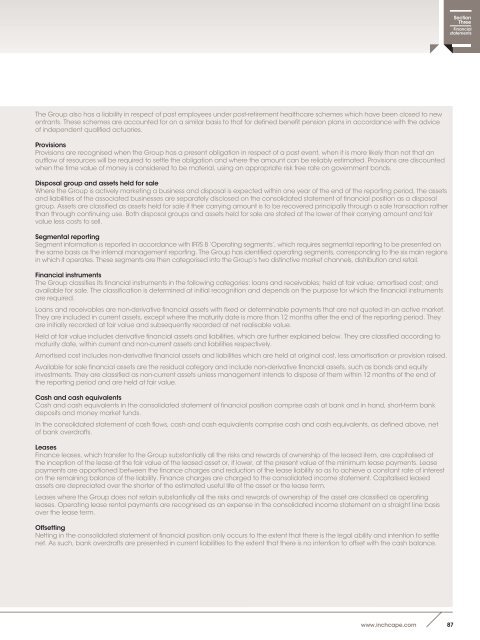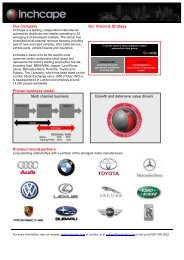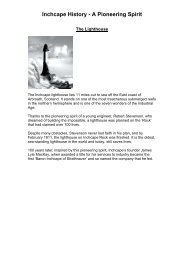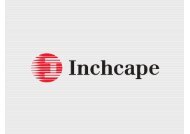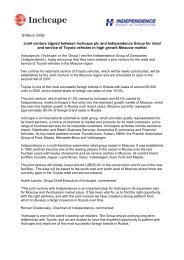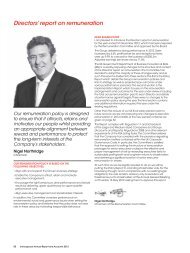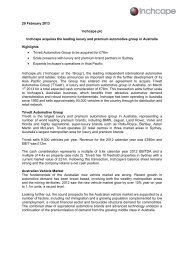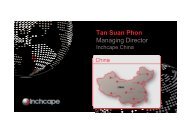Full Annual Report - Inchcape
Full Annual Report - Inchcape
Full Annual Report - Inchcape
Create successful ePaper yourself
Turn your PDF publications into a flip-book with our unique Google optimized e-Paper software.
Section<br />
Three<br />
Financial<br />
statements<br />
The Group also has a liability in respect of past employees under post-retirement healthcare schemes which have been closed to new<br />
entrants. These schemes are accounted for on a similar basis to that for defined benefit pension plans in accordance with the advice<br />
of independent qualified actuaries.<br />
Provisions<br />
Provisions are recognised when the Group has a present obligation in respect of a past event, when it is more likely than not that an<br />
outflow of resources will be required to settle the obligation and where the amount can be reliably estimated. Provisions are discounted<br />
when the time value of money is considered to be material, using an appropriate risk free rate on government bonds.<br />
Disposal group and assets held for sale<br />
Where the Group is actively marketing a business and disposal is expected within one year of the end of the reporting period, the assets<br />
and liabilities of the associated businesses are separately disclosed on the consolidated statement of financial position as a disposal<br />
group. Assets are classified as assets held for sale if their carrying amount is to be recovered principally through a sale transaction rather<br />
than through continuing use. Both disposal groups and assets held for sale are stated at the lower of their carrying amount and fair<br />
value less costs to sell.<br />
Segmental reporting<br />
Segment information is reported in accordance with IFRS 8 ‘Operating segments’, which requires segmental reporting to be presented on<br />
the same basis as the internal management reporting. The Group has identified operating segments, corresponding to the six main regions<br />
in which it operates. These segments are then categorised into the Group’s two distinctive market channels, distribution and retail.<br />
Financial instruments<br />
The Group classifies its financial instruments in the following categories: loans and receivables; held at fair value; amortised cost; and<br />
available for sale. The classification is determined at initial recognition and depends on the purpose for which the financial instruments<br />
are required.<br />
Loans and receivables are non-derivative financial assets with fixed or determinable payments that are not quoted in an active market.<br />
They are included in current assets, except where the maturity date is more than 12 months after the end of the reporting period. They<br />
are initially recorded at fair value and subsequently recorded at net realisable value.<br />
Held at fair value includes derivative financial assets and liabilities, which are further explained below. They are classified according to<br />
maturity date, within current and non-current assets and liabilities respectively.<br />
Amortised cost includes non-derivative financial assets and liabilities which are held at original cost, less amortisation or provision raised.<br />
Available for sale financial assets are the residual category and include non-derivative financial assets, such as bonds and equity<br />
investments. They are classified as non-current assets unless management intends to dispose of them within 12 months of the end of<br />
the reporting period and are held at fair value.<br />
Cash and cash equivalents<br />
Cash and cash equivalents in the consolidated statement of financial position comprise cash at bank and in hand, short-term bank<br />
deposits and money market funds.<br />
In the consolidated statement of cash flows, cash and cash equivalents comprise cash and cash equivalents, as defined above, net<br />
of bank overdrafts.<br />
Leases<br />
Finance leases, which transfer to the Group substantially all the risks and rewards of ownership of the leased item, are capitalised at<br />
the inception of the lease at the fair value of the leased asset or, if lower, at the present value of the minimum lease payments. Lease<br />
payments are apportioned between the finance charges and reduction of the lease liability so as to achieve a constant rate of interest<br />
on the remaining balance of the liability. Finance charges are charged to the consolidated income statement. Capitalised leased<br />
assets are depreciated over the shorter of the estimated useful life of the asset or the lease term.<br />
Leases where the Group does not retain substantially all the risks and rewards of ownership of the asset are classified as operating<br />
leases. Operating lease rental payments are recognised as an expense in the consolidated income statement on a straight line basis<br />
over the lease term.<br />
Offsetting<br />
Netting in the consolidated statement of financial position only occurs to the extent that there is the legal ability and intention to settle<br />
net. As such, bank overdrafts are presented in current liabilities to the extent that there is no intention to offset with the cash balance.<br />
www.inchcape.com 87


